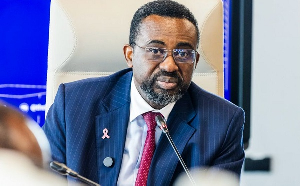– Reflections On The Ghanaian Economy
Mohammed Amin Adam
Ibis Ghana
INTRODUCTION
Budgets have become annual rituals and have defined the directions of the economy. It therefore does not evoke the level of interests it did in the past. However, the last two Budget Statements of the Government of Ghana have been significant for two reasons. First, the introduction of oil revenues to the budget has raised expectations of Ghanaians for improvement in their living conditions and whether oil could provide that boost is a function of its management which the Budget has responsibility for. Second, Ghana has attained a lower middle income status, which imposes enormous responsibility on the country’s ability to sustain growth and distribute it for the benefit of majority of the population and once again, the Budget is an important instrument for showing how this could be done. Both developments require high level of vigilance by citizens and regular analysis of the impact of budget prescriptions. This paper attempts to analyze the management of oil revenues since they were introduced in the budget and its impact on the economy of Ghana.
DISPARITY IN OIL PROCEEDS
There have been some reported disparities in oil receipts for 2011. In the Supplementary Budget for the year, Government projected to receive GH¢1.2 billion from oil including corporate taxes of about GH¢600 million. This is by far more than the GH¢506 million actually received according to the 2012 Budget Statement.
Table 1: Disparity in Oil Receipts
Revenue Stream Target (GH¢ mil) Actual (GH¢ mil)
Total Oil Revenue 1,250 506.0
Royalties 201.25 140.1
Carried and Participating Interest 445.77 365.9
Corporate Taxes 603.76 NIL
Sources: Ghana Supplementary Budget 2011; 2012 Budget Statement
The shortfall is due to non-payment of corporate taxes. Government has explained in the Budget statement that the non-payment of corporate taxes by oil companies resulted from ‘the impact of carry-forward losses’. Whiles it is appreciated that oil companies do not pay corporate taxes if they do not declare profits according to Ghana’s income tax laws, this particular case needs further explanation. The Supplementary Budget was submitted to Parliament in July, 2011, seven clear months from the first export of oil, at which time Government should have known if the companies were making profits. Moreover, the Oil Companies filed their quarterly tax returns with the Ghana Revenue Authority which did not show any declaration of profits. One wonders what informed the projections for corporate taxes in the Supplementary Budget. This clearly raises problems in budget planning, revenue forecasting and lack of understanding of the petroleum contracts.
The effect of the shortfall is understandable. It has affected the transfers to the budget and the Petroleum Funds. The following table shows the projected and actual transfers.
Table 2: Deviation in Projected and Actual Transfer of Oil Revenues for 2011
Transfers Target (GH¢ mil) Actual (GH¢ mil) Variance (Amount)
Annual Budget Funding Amount 646.4
168.0 (-) 478.4
Ghana Stabilization Fund 193.9
82.2
(-)111.7
Ghana Heritage Fund 83.1 21.6 (-)61.5
Total Benchmark Revenues 923.4
271.8 (-)651.6
Source: 2012 Budget Statement
The disparities are quite wide (about 74%) and could put the Government spending plan off-balance. That is, rather than spend GH¢646 million and save GH¢277million, Government has spent GH¢168 million and saved GH¢103 million. The Government explanations of the effect of the revenue shortfall as captured in the 2012 Budget Statement is quoted below:
‘The negative impact of a shortfall in official grants and oil revenues due to lower production volumes and the impact of carry-forward losses on corporate tax payments by the oil producing companies will be mitigated by over-performance in domestically-generated revenue’.
This is commendable. However, the revenues from the over-performance in domestic revenue generation were not allocated to the planned programme under oil revenue spending – the four priority sectors. So whiles Government fiscal targets would have been met, the targets for oil revenue allocations have not been met.
For the 2012 fiscal year, based on expected crude oil price of US$90 per barrel and an average production volume of 90,000 barrels per day, Government has again projected to collect corporate taxes amounting to GH¢384.11 million. This means that the projected profit for the oil companies is GH¢1,097 million. What is not clear is the basis for the profits in terms of the amount of capital costs to be recovered for the year 2012 and how much will be carried forward from 2011. Until these explanations are given, the projections for 2012 remain very doubtful.
Table 3: Expected Revenues for 2011 Fiscal Year
Expected Oil Revenue Amount (GH¢ million)
Total Annual Oil Revenue 1,239.82
Royalties 236.87
Carried and Participating Interest 618.84
Corporate Taxes 384.11
Source: 2012 Budget Statement
Petroleum corporate taxes constitute an important source of oil revenues and Government should be serious about it. Unfortunately, Government has chosen to further undermine the nation’s chances of earning more revenues by placing before Parliament an amendment to peg the corporate taxes at 35% significantly below the maximum of 50% provided for in the Petroleum Income Tax Law (PNDCL 188). This is in spite that the risk profile in Ghana’s oil industry has considerably reduced following significant commercial discovery and production, stability of contracts and political stability.
The application of the Petroleum Revenue Management Act of 2011 (Act 815) for the 2011 allocations has also been problematic. The Annual Budget Funding Amount is supposed to be 70% of benchmark revenues, whiles the Stabilization and Heritage Funds receive 21% and 9% respectively. The following table however shows that the formula has not been religiously applied.
Table 4: Discrepancies in Transfer of Oil Revenues for 2011
Allocation Benchmark Revenues ABFA (70%) Stabilization (21%) Heritage
(9%)
Budget Actual (GH¢ mil) 271.8 168.0 82.2 21.6
According to the Law (GH¢ mil) 271.8 190.26 57.08 24.46
Variance 0.00 (-)22.26 25.12 (-)2.86
Source: 2012 Budget Statement
From Table 4, the Annual Budget Funding Amount has been under-declared by GH¢22 million whiles the Heritage Fund has been under-declared by GH¢2.86 million. However, the Stabilization Fund has been over-declared by GH¢25 million. Cumulatively, the over-declaration in the Stabilization Fund has been cancelled by the under-declarations in the Budget Funding Amount and the Heritage Fund. That is, the extra GH¢25 million in the Stabilization Fund does not belong there. It must be divided between the Budget Funding Amount and the Heritage Fund to balance the accounts. This is a quantitative error which must be addressed for accountability purposes.
It is important to state that the application of the law to the allocations for 2012 is however correct based on projected oil revenues for the year. This is shown as follows.
Table 5: Projected Transfers of Oil Revenues for 2012
Allocations Amount (GH¢ million)
Total Oil Revenues 1,239.82
Transfers to GNPC 361.90
Benchmark Revenues (BR) 877.92
ABFA(70%ABFA) 614.55
Transfers to Petroleum Funds (30%ABFA) 263.28
Source: 2012 Budget Statement
DITSRIBUTION OF OIL REVENUES
In line with the Petroleum Revenue Management Act of 2011 (Act 815), the Minister of Finance is required to prioritize four sectors for spending oil revenues. In the Supplementary Budget of 2011, the Minister prioritized amortization of oil and gas loans, road infrastructure, agricultural modernization and capacity building. The Table below presents the expenditure distribution of oil revenues by priority.
Table 6: Priority Expenditure
ITEM Expenditure (GH¢ million) %
1. Expenditure and Amortization of loans for oil and gas infrastructure 20,000,000.00 12
2. Road Infrastructure 134,102,367.20 79.8
3. Agricultural Modernization 13,147,652.00 7.8
4. Capacity Building (including oil and gas) 750,000.00 0.4
Total ABFA 168,000,019.20 100
Source: 2012 Budget Statement
The budget further provided expenditure on specific projects. However, a regional distribution of expenditures indicate that whiles all regions in the country benefitted from oil revenues for the 2011 fiscal year, some regions received more revenues or projects than others.
Table 7: Regional Distribution of Oil Revenue based Expenditures
Region Amount (GH¢ million) Percentage (%)
Greater Accra 3,935,581.31 2.3
Ashanti 12,864,004.37 7.7
Eastern 63,821,794.84 38
Western 16,946,647.10 10
Central 2,553,931.81 1.5
Volta 8,365,521.64 5
Brong Ahafo 18,218,381.52 10.8
Northern 5,099,412.00 3
Upper East 1,650,000.00 1
Upper West 2,012,082.59 1.2
Agric projects in Northern Savannah 848,917.00 0.5
National Agric projects 11,683,735.00 7
Ghana Gas Company 20,000,000.00 12
ABFA 168,000,019.20 100
Source: 2012 Budget Statement
The interesting revelation from the regional distribution of oil spending is that 10% of the ABFA was allocated to the Western Region. This coincidentally reflects the demand by the chiefs and people of the region in their petition to Parliament. Can this therefore be considered a fulfilment of the demand by the region which has become known as the oil region?
The Table also shows that other regions got more than 10% of the ABFA and therefore it is uncertain whether the Western region would have gotten more if they had not reduced their demand to 10% of oil revenues. It is significant though to state that the region has more than been compensated by the decision of the Government to allocate for projects in the region almost half of the US$3 billion Chinese loan to be repaid with future oil revenues. On that basis, the Western region is actually receiving more. Some of the projects to be undertaken in the region include:
i. Western Corridor Petroleum Terminal Project;
ii. Western Corridor Infrastructure Renewal Project (Western Railway Line Modernization and Takoradi Port Rehabilitation/Retrofit);
iii. Sekondi Free Zone Project;
iv. Development of ICT Enhanced Surveillance Platform for Western Corridor “Oil Enclave.
HAS GHANA EXPERIENCED THE ‘DUTCH DISEASE’?
Dutch disease describes a phenomenon in which an increased inflow of foreign capital leads to real appreciation of the local currency. This then makes the country’s exports relatively more expensive and thereby internationally non-competitive. The effect of this is to slow down the growth of manufacturing and agricultural sectors of the economy leading to high rates of unemployment and lower growth grates. This is a manifestation of what has become known as the ‘resource curse’.
A symptomatic analysis of the performance of the economy evidenced by the statistics provided by the 2012 Budget statement shows that Ghana has shown signs of the ‘Dutch disease’ in the economy. This analysis looked at three components of the economy that explain the ‘Dutch disease’ – exchange rate movement, the growth of exports and the contribution of the oil subsector relative to manufacturing and agricultural growth.
i. Real Exchange Appreciation
In the Budget Statement, the Ghana cedi is said to have depreciated more in 2011 than in 2010. In spite of this depreciation, there appears to be real appreciation in the currency.
Figure 1: Nominal Versus Real Exchange Rates (GHC/US$)
Sources of Data: Bank of Ghana Statistical Bulletin 2011, Ghana Statistical Service and U.S. Department of Labour Bureau of Labour Statistic.
Real exchange rate can be defined as nominal exchange adjusted to the ratio of international price levels to domestic price levels. Representing international prices as tradable prices and domestic prices as non-tradable prices, a decline in the real exchange rate means a real appreciation in the exchange rate indicating a lower international competitiveness of the country’s tradable goods. Using the Consumer price Index (CPI) of the United States of America where the bulk of Ghana’s oil was exported as the price of tradable goods and Ghana’s Producer Price Index (PPI) as the price of the non-tradable goods, the results show a real exchange appreciation in Ghana’s cedi relative to the US dollar. The notion about ‘Dutch disease’ in Ghana is therefore real.
The Government has already indicated in the Budget its readiness to pass an Industrial Competitiveness Bill to facilitate the creation of a competitive manufacturing sector and the promotion of the use of local content. This cannot be delayed any further as the manufacturing sector will continue to face stiffer competition as a result of continuous occurrence of the ‘Dutch disease’.
ii. Export Performance
The performance of exports in 2011 also shows the economy has experienced the ‘Dutch disease’. In spite of the record One million tonnes of cocoa achieved, in real terms the growth of the cocoa sector in 2011 over 2010 was not better than the growth in 2010 over 2009. The following table shows the decline in the growth of exports in value terms.
Table 8: Export Growth Performance
Exports 2009
(US$ mil) 2010
(US$ mil) Growth
(2009-2010) 2011
(US$ mil) Growth
(2010-2011)
Cocoa 1,866.03 2,219.54 18.9% 2,619.60 18.0%
Gold 2,551.36 3,803.52 49.0% 5,307.90 39.5%
Others 1,422.31 1,937.02 36.1% 2,356.30 21.6%
Source: 2012 Budget Statement
Cocoa and gold exports grew at 18.9% and 49% respectively in 2010 over 2009. These fell to 18% and 39% respectively over 2010-2011 period. The trend holds for other export commodities. Whiles it requires an econometric analysis to explain the relationship between real exchange rate and exports, it cannot be entirely a coincident that the decline in export growth occurred at the same time as real exchange rate appreciation.
iii. The Contribution of the Oil subsector relative to Manufacturing and Agricultural Growth
Due to the significant contribution of petroleum output to the Mining and Quarrying subsector, the sub-sector’s share in GDP increased from 1.8 per cent in 2010 to 8.7 per cent in 2011. In spite of the contribution of the industrial sector to growth, the manufacturing sub-sector contribution to industrial sector performance fell substantially from 7% in 2010 to 1.7% in 2011. For the agricultural sector, it underperformed growing at 2.8% of total economic growth in 2011 against a target of 5.3% and an actual outturn of 5.3% in 2010. The contribution of the fisheries sub-sector also declined from 5% to 1.7% in total agricultural sector growth for the same period. The decline in agricultural growth has been attributed to the low performance of forestry and logging. But the analysis of exchange rate movement and the growth of exports show that the low performance in forestry and logging cannot be entirely held responsible for the decline in agricultural growth. The ‘Dutch disease’ is therefore already here and must be addressed with urgency.
CONCLUSIONS
Generally, the 2012 Budget Statement is an improvement on the 2011 Budget and its Supplementary version in terms of the application of the Petroleum Revenue Management Act, 2011 (Act 815). The report on the management of oil revenues as part of the annual budget is a legal requirement and this has also been fulfilled. The only exception is the component on the investments of revenues transferred to the Petroleum Funds including the instruments invested in and if there have been any interests accrued to the Funds.
The performance of the economy has been hailed considering the unprecedented growth of about 13% on the back of oil production. However, ‘not all that glitters are gold’ as the economy slowly shows symptoms of ‘Dutch disease’ which could undermine the growth long-term development of the country. Particularly, its effects on manufacturing and agriculture, which employ the bulk of the working population, could compound the unemployment problem and low productivity in the country.
Government must develop a comprehensive Public Investment Management Policy which takes into consideration the level of absorptive capacity of the economy. This should direct investments to sectors that have significant multiplier effect, and capable of increasing economic growth on a sustainable basis. Government has already signalled its intention to develop a Public Investment Programme which will provide ‘a systematic, coordinated and comprehensive manner, planned public infrastructure investment over the next five years’.
The institutional and legislative reforms that address the weaknesses in the management of oil revenues must also be given critical attention as there is evidence that the quality of institutions determine the productive management of oil revenues.
Fortunately, the Budget promises a number of institutional reforms as well as important legislations that are required for the effective management of the oil and gas sector. Some of the reforms are the introduction of an activity based Medium Term Expenditure Framework (MTEF) and development of a Budget and Public Expenditure Management System (BPEMS). Other reforms which are already being implemented include the Ghana Integrated Financial Management Information System (GIFMIS), Programme Based Budgeting (PBB) and Wage and Payroll Management.
In terms of policy and legislative frameworks, the following are being considered: - the Natural Gas Master Plan, Petroleum (Exploration and Production) bill, Local Content Bill and Marine pollution Bill. Some regulations are also being developed including Shipping Services providers’ Regulations, Regulations on inland waterways and Regulations to license ship manning agencies. These legislations when passed will have significant implications for the oil and gas sector and Parliament is critical at this point to scrutinize the bills as it has done before and pass laws that will stand the test of time.
Opinions of Friday, 25 November 2011
Columnist: Adam, Mohammed Amin














